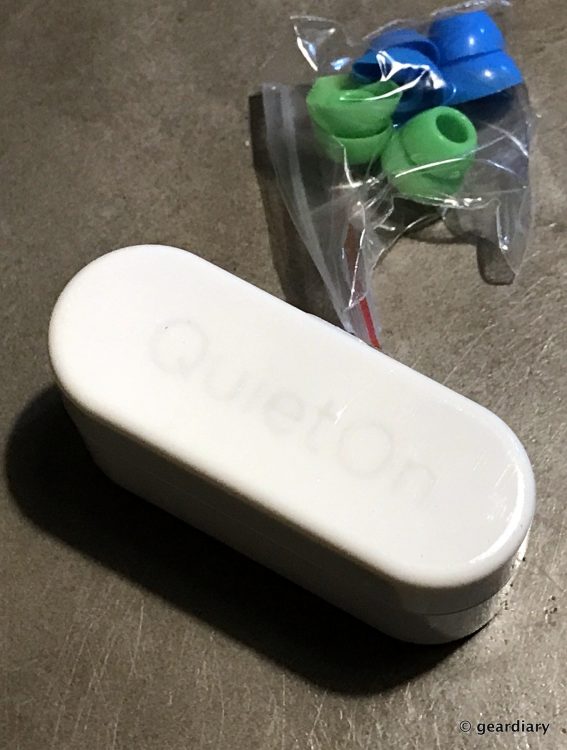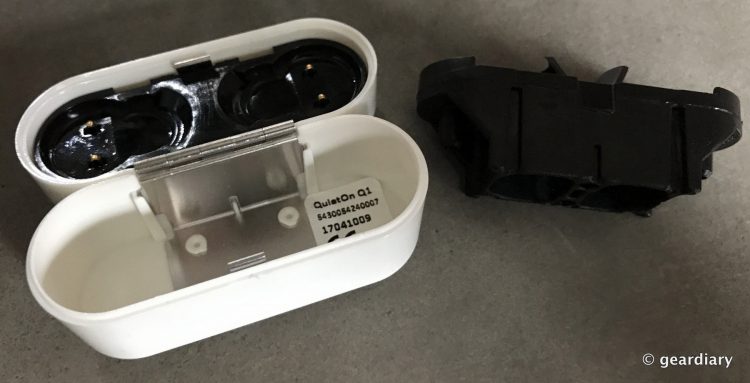My husband snores. not all the time but sometimes, and if I don’t fall asleep before he does, his snoring can keep me awake. Kev’s had a sleep test (there’s no sleep apnea), and he’s tried various anti-snore devices to no avail. I’ve tried earplugs, but they block everything (like alarms); it’s better to use QuietOn Active Noise Cancelling Earplugs.

QuietOn says that their earplugs combine active noise cancellation and acoustic noise attenuation to help create silence so that you can sleep in less than optimal situations; those situations can include sleeping on a plane, sleeping near construction, sleeping next to a snorer, or sleeping with weird background noises — like a nearby windmill or other distractions. They are not made to play music; they are simply to make things quieter so that you can sleep (or work) without distraction.
Included in the box are the QuietOn earplugs, a charging case, a set of foam ear tips, and two different sizes of silicone flanged ear tips.

The charging case uses microUSB to charge, but a charging cable is not included in the box. While it’s true that most of us probably have a drawer of extra microUSB cables (wait, I’m not the only one, right? Right?), I do think that one should have been included just in case, because not every person out there may have a spare.
When the QuietOn Active Noise Cancelling Earplugs are charging inside their case, you’ll see two blue LEDs glowing through the case; the lights will go out once charging is complete which takes about an hour.

The QuietOn Active Noise Cancelling Earplugs charge when placed into the plugged-in case, and they turn on automatically when they are removed from the case.

To use them, you are supposed to place the QuietOn Active Noise Cancelling Earplugs firmly, deep inside your ear with whichever set of ear tips fits and feels best. You may hear a slight squealing (similar to the feedback sound hearing aids sometimes make) when you put them in your ear, but once they are properly positioned, you’ll notice lowered levels of background noise. They need to be airtight in your ear to get optimal performance, and if you still hear any beeping or feedback when they are in your ear, it means they haven’t been placed quite right.

Charging the earplugs is accomplished by the two metal pins on each side of the case’s top touching the metal tops of the earplugs, and the bottom of the case doesn’t hold a battery for cordless charging on the go, so you can use this space to carry extra tips if you’d like to have an assortment with you at all times.

The QuietOn Active Noise Cancelling Earplugs fit comfortably inside the lower concha of the ear, tucking into the hollow there. I’m a side sleeper, and I didn’t find them to be uncomfortable when inserted with my firmer than usual side-sleeper pillow; as long as they are tucked properly into my ear, I don’t feel them after an initial moment or two of “oh yeah, there’s something in my ear”.

QuietOn Active Noise Cancelling Earplugs are not meant to be used in loud environments that typically require noise protection, as it is not a hearing protection device. They do not remove all noise completely, so they aren’t meant to be used on the job site; using them at a concert is also not an intended use.

QuietOn Active Noise Cancelling Earplugs are not waterproof, so you should never get them wet as it can cause a short-circuit resulting in a fire. Eek!
The battery in the Quiet Active Noise Cancelling Earplugs is supposed to last for up to 50 hours, which makes them ideal for travel and work; bear in mind that it’s not recommended that you overcharge them (by keeping the case plugged in at all times with the earplugs inserted).
QuietOn’s active noise cancellation is specially focused to reduce low frequency ‘bass’ noise that you frequently encounter traveling by train, airplane, bus, or motorcycle. This allows for active noise cancelling up to 40 dB, putting QuietOn at the level of the best on-ear noise cancelling headphones.
I recently used them on a 3.5-hour flight from New York to Dallas, and I found that they did cut out much of the rumbling engine noise, but they didn’t make it impossible to hear people speaking or plane announcements. So they cancel out the low hum without removing the higher pitched noises.
Of course, the real test (for me, anyway) came when using them while sleeping next to my particular snorer. With the QuietOn Active Noise Cancelling Earplugs in place, I can still hear bits of Kev’s low, rumbly snoring, but the snoring is reduced enough that I can sleep without eventually moving to the couch. I also noticed that in the ear which was on the pillow, I could hear a “white noise”
While I would love to be able to say that all snoring sounds will be completely blocked when you have the QuietOn ear plugs in place, just as every snorer is a different person, the sounds they make are also different. Depending on what the snorer you are trying to block typically sounds like (whether their snores are a low rumbling or a high-pitched wheezing), you may or may not find QuietOn as effective as you’d like or need. But because of the QuietOn ear plugs, I was able to rest — even with Kev snoring next to me — and yet I also heard the alarm go off in the morning and a text message I was expecting before that. Success!
The QuietOn Active Noise Cancelling Earplugs retail for $199, and they are available in the US from Amazon [affiliate link].
Source: Manufacturer supplied review sample
What I Like: Wireless; Charge inside their carrying case; They turn on when you remove them from the case and they turn off when placed back into the case; I found them comfortable for sleeping, but your mileage may vary
What Needs Improvement: MicroUSB charging cable not included; Does not block all snoring or background sounds; Not made to be used as hearing protection in noisy environments





À quand une version avec atténuation à fréquence paramétrable avec le smartphone ?!